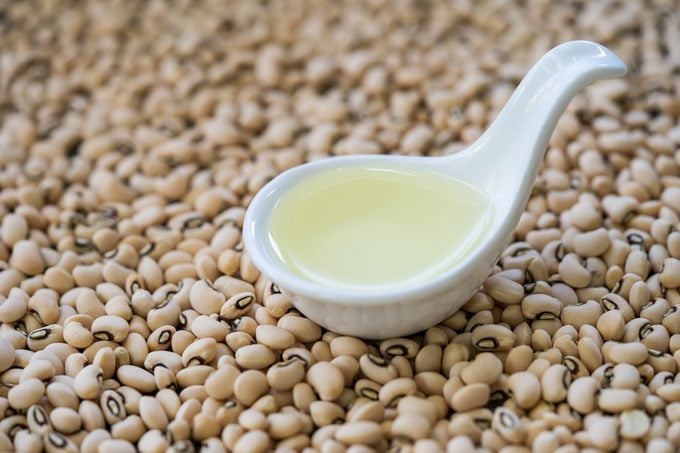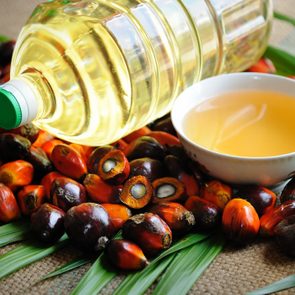Is Soybean Oil Bad for You? 10 Nutrition Facts You Should Know
Updated: Mar. 17, 2022
Soybean oil is a widely consumed oil used in thousands of packaged foods. Learn more about this component of most vegetable oil, including the calorie content and smoke point.
Is soybean oil really vegetable oil?
Do you have a bottle of vegetable oil in your pantry? Though many of the bottles feature colorful vegetables on the label, the main ingredient in most vegetable oils is actually just one vegetable—soybeans.
In fact, soybean oil is the most common vegetable oil in the United States. Besides straight-up soybean oil, the gluten-free oil is in foods like salad dressings, cookies, potato chips, baked goods, and granola bars, just to name a few.
We can’t stroll down a grocery aisle without seeing soybean oil on the ingredients label, but does that mean it’s good for us? Keep reading to find out what nutritionists say.
How is soybean oil made?
With soybean oil as an ingredient in so many packaged foods, it’s no wonder soybeans are the second-largest crop grown on U.S. soil. But how do soybeans turn into oil?
Soybeans grow in pods. The pod is green and usually filled with three green soybeans. Soybeans are ready for harvest when the pod dries out and turns brown. The tiny soybeans inside make a rattling noise when shaken.
After harvesting the soybeans, the processing begins. Soybeans go through a double cleaning and drying process; then, they’re cracked and de-hulled. The cracked beans are heated up and rolled into flakes.
A solvent wash removes the oil from the flakes as they move through the extractor. Once refined, bleached, and deodorized, it is ready for edible and non-edible uses such as cooking oil, packaged foods, biofuels, pharmaceuticals, and even paints.
Nothing goes to waste. People use the flat flakes as a protein source for pet food and livestock feed.
Soybean oil nutrition profile
Here’s the nutrition profile for one tablespoon of soybean.
- Calories: 120
- Total fat: 13.6 g
- Saturated fat: 2.12 g
- Polyunsaturated fat: 7.85 g
- Monounsaturated fat: 3.1 g
- Vitamin K: 25 mcg (21 percent DV)
- Vitamin E: 1.1 mg (7 percent DV)

A healthy dose of Vitamin K
Vitamin K lends a hand in making the proteins used for blood clotting to help wounds heal. It also plays a significant role in regulating bone metabolism and synthesizing specific proteins essential for maintaining bone mass.
Though vitamin K deficiency is rare, it can occur in ill adults who have certain chronic conditions.
Research in the American Journal of Clinical Nutrition found that women with a lower intake of vitamin K (70.2 micrograms versus women who took 309 mcg) were associated with lower bone density mass.
A good source of Vitamin E
Vitamin E is an antioxidant superstar whose role is to fight nasty free radicals that can cause disease. It also is a vital component in boosting your immune function by assisting cells in fighting off infection, according to research published in the journal IUBMB Life.
Vitamin E also aids in preventing blood clots from developing in heart arteries, per a report in Antioxidants.
Soybean oil flavor and smoke point
This oil has a neutral flavor, which means it won’t compete with or overpower the flavors you’re trying to preserve.
Smoke points are also something to consider when choosing a cooking oil. Oils with low smoke points burn easily if they get too hot, and the fats break down, leading to the release of harmful free radicals, which could cause oxidative stress.
“Soybean oil has a high smoke point, making it a more versatile oil to cook with, and it can be used in a variety of cooking methods,” says registered dietitian nutritionist Kristin Smith, spokesperson for the Academy of Nutrition and Dietetics.
Soybean oil has a smoke point of 450 degrees Fahrenheit. By comparison, canola oil‘s smoke point is 400ºF, extra virgin olive oil‘s is 325ºF to 375ºF, and butter’s is 302ºF.
Fatty acids in soybean oil
When it comes to oils, there’s usually a mixture of good and bad fats.
“All oils are a combination of several types of fat structures. They’re somewhat like family members that are related, but look and act differently,” says registered dietitian nutritionist Julie Stefanski, MEd, spokesperson for the Academy of Nutrition and Dietetics.
For example, soybean oil is mostly polyunsaturated fats. That’s good news when you’re trying to replace unhealthier options like palm oil, margarine, or butter.
“Studies have shown the benefits of improving heart health when saturated and trans fats are replaced with polyunsaturated (and monounsaturated) fat,” says Smith, referencing research in the journal Nutrition, Metabolism, and Cardiovascular Diseases.
Specifically, linoleic acid, found in soybean oil, plays a role in lowering bad cholesterol, which reduces coronary heart disease death, according to the study.
Linoleic acid is an omega-6 fatty acid and is considered essential, as our bodies don’t make linoleic acid. But our diets aren’t exactly lacking in omega-6.
“Americans get plenty of fat in their diets, most of it as soybean oil, which is often combined with large portions of carbohydrates in foods such as baked goods, fried foods, and snack foods,” says Stefanski.
The balance of fatty acids in soybean oil
Omega-3 and omega-6 are part of the polyunsaturated family. People consume too much omega-6 from not-so-great sources like snack foods, baked goods, and fast foods.
“Some theories have focused on the imbalance of omega-6 fats with omega-3 fats in our current standard American diet as a contributor to inflammation,” says Stefanski. “Recent research [in Circulation], though, based on human trials, has not fully supported the idea that omega-6 fats are pro-inflammatory.”
It is important to remember that it isn’t clear yet how different fats promote and resolve inflammation in the body. Nor do scientists understand how to control inflammation fully, says Stefanski.
Still, choosing healthier sources of omega-6 in whole foods such as walnuts, peanut butter, eggs, and tofu is more nutritious than packaged foods with soybean oil, which also tend to be high in sugar, salt, and fat.
Oils high in oleic acid may protect your heart
Oleic acid is a type of monounsaturated fat in soybean oil. In 2018, the U.S. Food and Drug Administration (FDA) authorized a qualified health claim that oils high in oleic acid, such as high-oleic soybean oil, may reduce the risk of coronary heart disease.
Food companies that meet FDA requirements can add this claim to their label:
“Supportive but not conclusive scientific evidence suggests that eating about 1 1/2 tablespoons (20.5 g) daily of soybean oil, which contains unsaturated fat, may reduce the risk of coronary heart disease. To achieve this possible benefit, soybean oil is to replace saturated fat and not increase the total number of calories eaten in a day. One serving of this product contains [x] grams of soybean oil.”
Note that the key is that soybean oil should replace the saturated fat you are currently eating while not increasing the total number of calories you’re eating daily.
“Keep in mind, as with any fat, soybean oil can contribute significant calories when eaten in large amounts,” Smith cautions. The 1 1/2 tablespoon in the health claim adds up to 180 calories.
Some research isn’t glowing toward soybeans
A February 2020 study, published in the journal Endocrinology, linked soybean oil consumption to genetic changes in the brain. However, this was a study based on feeding mice (male only) soybean oil.
“Some researchers have pointed out that it’s important not to directly correlate studies in mice to humans when it comes to fatty acids and inflammation, as there are distinct differences in how mice utilize fatty acid DHA which can impact inflammatory markers and response,” Stefanski says.
The bottom line
So what’s the verdict on whether soybean oil is good or bad for you?
“Our meal patterns, or the way that we choose different foods day in and day out, are much more important than single food items when it comes to health,” Stefanski says. “While it may not be necessary to cut soybean oil out of your diet totally, it’s wise to choose other sources of fats, too.”
Here are some other things Stefanski and Smith say to keep in mind when using this oil:
- Soybean oil can be part of a healthy diet when eaten in moderation.
- It’s best not to rely on soybean oil as your only source of fat in your diet. Include various healthy fat sources such as nuts, seeds, fatty fish, eggs, avocados, and flaxseed.
- When adding soybean oil to food, drizzle rather than pouring on large amounts.
- Prepare meals without a lot of added fat and use a variety of oils to enhance flavor and avoid an abundance of one single type of fat.
- Choose brightly covered veggies as side dishes instead of a fried starchy veggie to reduce oil intake.























